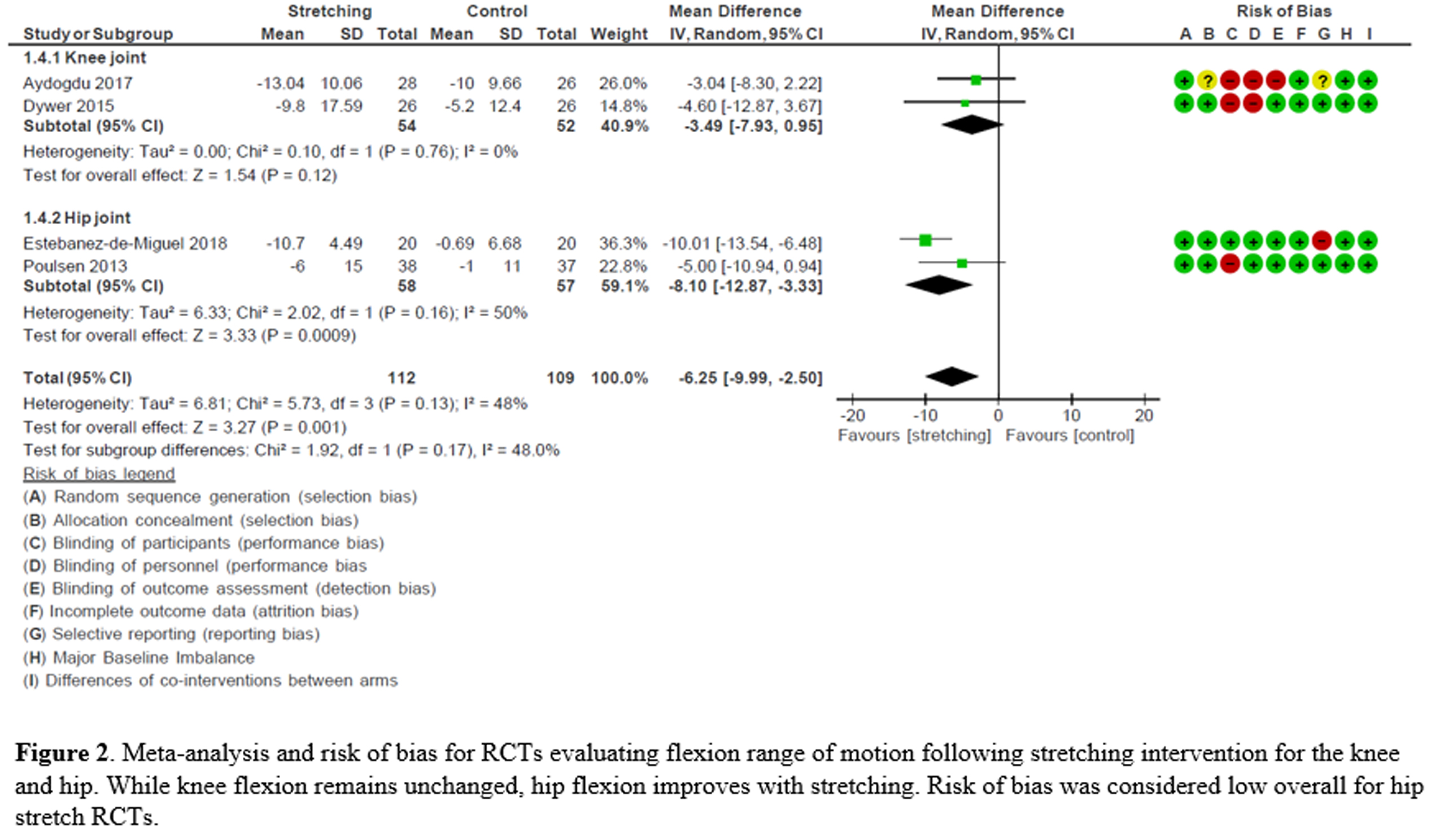Session Information
Session Type: Poster Session C
Session Time: 8:30AM-10:30AM
Background/Purpose: Many patients with osteoarthritis (OA) develop range of motion (ROM) restrictions in their affected joints (contractures), leading to worse pain and function. OA-related contractures are associated with more rapid progression to arthroplasty, contributing to rising health care costs. Effective treatment guidance for lost ROM in OA-affected joints is lacking. Our objective is to perform a systematic review and meta-analysis evaluating the effectiveness of stretching and/or bracing protocols on native (non-operated) joint ROM in people with radiographically-diagnosed OA.
Methods: We searched 7 databases CENTRAL, DARE, HTA, Medline, Embase, CINAHL, SCI-EXPANDED and PEDro. We included English-language studies evaluating stretching or bracing in participants with radiographically-diagnosed OA in any joint, prior to arthroplasty. Two reviewers independently screened titles and abstracts for inclusion and assessed risk of bias in included randomized controlled trials (RCTs) using the Cochrane Risk of Bias tool. Primary outcomes were ROM, pain and adverse events (AEs). A random-effects meta-analysis was performed when appropriate.
Results: We identified 4282 articles through database searching. Eight RCTs and 1 non-RCT met our eligibility criteria and provided adequate data for analysis (Figure 1, Table 1). Of these studies, 5 involved the knee joint, two the hip, and one the hand distal interphalangeal (DIP) joint. Three RCTs found no changes in knee flexion or extension after stretching while 1 reported increased ROM without specifying direction. Meta-analysis (n=2 studies, 1 using long-axis distraction mobilization and 1, manual therapy) showed improvement in hip flexion of 8.1° (95% CI 3.3,12.9°; Figure 2), and 1 RCT reported increased hip extension (7.8°; 95% CI 4.8,10.9°), abduction (6.2°; 95% CI 3.5,8.9), internal (7.6°; 95% CI 4.2,11.1°) and external (6.6°; 95% CI 3.6,9.5°) rotation using manual therapy. In 1 study, mean visual analogue pain reduction in the knee of 2.2 (95% CI –3.3,-1.1). One non-RCT showed that hand DIP joint splinting improved ROM. One study evaluating the hip reported an odds ratio of 4.5 (95% CI 0.9,23.0) for incurring an AE for manual therapy versus control. Risk of bias was generally rated low for studies showing improvement in ROM.
Conclusion: Stretching may be an effective strategy for improving ROM in the hip joint, while knee ROM may be more resistant to treatment. Differences in joint anatomy and biomechanical factors contributing to contractures may play a role in the observed outcomes. Stretching may also help OA-related pain. Stretching and bracing are appropriate conservative treatment options to improve OA outcomes prior to arthroplasty.
To cite this abstract in AMA style:
Campbell T, Ghaedi B, Ghogomu E, Westby M, Welch V. Effectiveness of Stretching and Bracing for the Treatment of Osteoarthritis-associated Joint Contractures Prior to Joint Replacement: A Systematic Review [abstract]. Arthritis Rheumatol. 2021; 73 (suppl 9). https://acrabstracts.org/abstract/effectiveness-of-stretching-and-bracing-for-the-treatment-of-osteoarthritis-associated-joint-contractures-prior-to-joint-replacement-a-systematic-review/. Accessed .« Back to ACR Convergence 2021
ACR Meeting Abstracts - https://acrabstracts.org/abstract/effectiveness-of-stretching-and-bracing-for-the-treatment-of-osteoarthritis-associated-joint-contractures-prior-to-joint-replacement-a-systematic-review/



